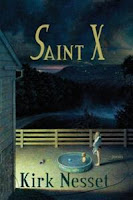Saint X
Kirk Nesset
Stephen F. Austin State University Press, 2012
Paperback, 80 pages
ISBN: 9781936205769
Reviewed by PQ Contributing Editor Shauna Osborn
Kirk Nesset’s Saint X chronicles the muted millennial age. Full of peculiar, recognizable figures, Nesset’s collection is a character filled book—people who wear bandages rather than smiles, misshapen champions downed by self-bludgeons. For example, “Your Own Master,” chronicles a female speaker airing her grievances who ends up rewarded with a pelting of fresh tomato. “Some Of The Most Striking Women I Have Known Have Been Men” uses the occasion of conferencing transsexuals and drag queens to discuss praising difference like saluting a banner.
Many of his descriptions are quite colorful and precise. Take, for instance, the first few lines in the second stanza of “Style:”
No sermons, she groaned, but notice
the jellyfish armies, the beach flea, the gribble
and limpet, this cryptic rabble of pebbles.
With just these few images, Nesset paints an entire beach scene. The choice of using the living creatures of this environment to invoke the more commonly described water and sand was a particularly smart one. Similarly, the opening lines in “The No-Theory Theory:”
Translucent, small as rice grains, unmoving
they dot walkways and lawns, porch railings,
decks, hoods of vehicles, millions riding in
on the rain—and while the science jabs the glass
slide with tweezers, nobody knows what they
are. There’s the airborne chemical spill theory,
Attempting to make the undetectable portions or our world visible is often not easy, but to take on two invisible subjects, microbes and ideas, in a single short poem is quite ambitious. This ambition is visible in a few other poems within the collection as well. Mostly, however, the poems in Saint X lack this. For example, “Café Perpendicular,” which paints the quintessential wine flavored kiss in the rain, brings Nesset’s perspective to the familiar scenario succinctly but brings nothing new to the cliché.
Saint X is a concise collection. In fact, all of the poems in the book are less than 30 lines long. Many have been given single word, broad and encompassing titles like “Island,” “Room,” and “Integrity.” This lack of specificity throughout the collection is troublesome. It only works when balanced well with fresh atypical descriptions that surprise the reader, which Nesset has been known to contribute occasionally. This becomes very apparent in poems like “Thing,” where the ambiguity of the broad title works because that ambiguity continues within the meat of the poem to add suspense. When this tactic is successful, it can create a splendid read. From the first stanza:
It leapt from malt liquor
in Emblem, Wyoming, learned
to stand in lake mud, half-sunk,
amongst skulls of gars; it grew up
lapping the tar paper roof
with its tongue.
The “thing” of the poem is never illuminated. Its description is clever throughout the stanzas and the poem overall is strong.
Saint X is in no way a perfect collection and overall this reader left disappointed. That being said, there are a few strong pieces within the collection that I thought were well written and fun to read.
Shauna Osborn is a Comanche/German mestiza who works as an instructor, wordsmith,and community organizer in Albuquerque, New Mexico. She received her Master of Fine Arts from New Mexico State University in 2005. Shauna has won various awards for her academic research, photography, and poetry. Her first collection of creative nonfiction is currently being considered for publication.

